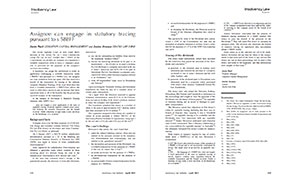Assignee can engage in statutory tracing pursuant to s 588ff

LCM’s Justin Ward and Justine Denman of Stacks Law Firm authored this case note on the ability of an assignee to engage in statutory tracing pursuant to s 588FF of the Corporations Act. This article was originally published in the LexisNexis Insolvency Bulletin (Vol. 21, No. 9 & 10).
Download PDF ArticleThe recent Supreme Court of New South Wales decision of Fitz Jersey Pty Ltd v Atlas Construction Group Pty Ltd (in liq)1 clarifies that s 588FF of the Corporations Act permits an assignee of a liquidator’s voidable transaction claim to trace a company’s property or proceeds for the purposes of the assignee’s recovery proceedings.
A liquidator can assign the entitlement to make an application challenging a voidable transaction under s 588FF;2 and pursuant to s 588FF(1)(c), the assignee can seek restitution from any party who has received a benefit of the transaction by tracing to the ultimate recipient (Statutory Tracing). If the court finds there has been a voidable transaction, s 588FF(1)(c) allows the court to order that a person to pay an amount that fairly represents some or all of the benefits that the person has received because of the transaction.
In the opinion of Stevenson J, Statutory Tracing pursuant subs 588FF(1)(c):
. . . does not require a strict application of the rules of equitable tracing. It merely requires common sense causation between the voidable transaction and the benefit received. Unlike a knowing receipt claim, it does not focus on the knowledge of a recipient.3
Background facts
A dispute arose over the final payment of a $160 million design and construct contract between Fitz Jersey Pty Ltd (Fitz Jersey) as developer and Atlas Construction Pty Ltd (Atlas) as principal.
On 6 January 2017, a $10.74 million adjudication determination pursuant to s 22 of the Building and Construction Industry Security of Payment Act 1999 (NSW) was made in favour of Atlas (Adjudication Determination).4
Atlas registered the Adjudication Determination and obtained a garnishee order which resulted in Atlas receiving about $11 million, being the total of the Adjudication Determination with interest and costs.5
In the days that followed Atlas’s receipt of the garnisheed amount, the directors of Atlas (the Directors) resolved to:
- pay out the outstanding tax liability Atlas owed to the Australian Taxation Office;6
- declare the following dividends to be paid to its shareholders — $6,103,403 to be paid to Kebzay Pty Ltd (Kebzay) (a company associated with one of Atlas’s directors) and $678,158 to be paid to Sweenham Pty Ltd (Sweenham) (a company associated with Atlas’s other director) (together referred to as Dividends);7 and
- write off shareholders’ loans owed by Sweenham and Kebzay8
Upon receiving the Dividends, Kebzay and Sweenham transferred the funds by way of a complex series of related party transactions.
On 4 April 2018, the Directors resolved to appoint voluntary administrators under Pt 5.3A of the Corporations Act and on 18 May 2018, Atlas’s creditors resolved to place the company into liquidation.9
The Liquidator admitted Fitz Jersey as a creditor of Atlas in the sum of approximately $10.7 million, which was then increased to $12.8 million.10
The Liquidator assigned to Fitz Jersey of a number of causes of action pursuant to Subdiv 100-5(1) of the Insolvency Practice Schedule (Corporations), being Sch 2 to the Act and s 477(2B) and 477(2)(c) of the Act.11
The court’s findings
Relevant to this article, the court found that:
- under the subject building contract, Atlas was not entitled to the amounts claimed in the Adjudication Determination and consequently, was not entitled to the garnisheed amount;12
- the declaration and payment of the Dividends was a voidable transaction for the purposes of s 588FC of the Act, by reason that it was:13
- an unfair preference for the purpose of s 588FA;
- an uncommercial transaction for the purpose of s 588FB;
- an unreasonable director related transaction for the purpose of s 588FDA;
- an insolvent transaction for the purposes of s 588FC; and
- in declaring the Dividends, the Directors acted in breach of the fiduciary obligations they owed to Atlas14
The payment by Atlas of the Dividends also contravened s 254T of the Corporations Act and was an alienation of property intended to defraud Atlas’s creditors for the purposes of s 37A of the NSW Conveyancing Act 2019.
Tracing of the dividends
Fitz Jersey made submissions (which were accepted by the Directors) that traced the proceeds of the Dividends and concluded:15
- proceeds of the dividend paid to Kebzay were ultimately paid towards the purchase of a property on behalf of one of Atlas’s directors and his wife (Mrs Yazbek); and
- proceeds of the dividend paid to Sweenham were ultimately used by a corporate entity associated with Atlas’s other director, Castlefield Corner Pty Ltd (Castlefield).
Fitz Jersey inter alia joined the Directors, Kebzay, Sweenham, Mrs Yazbek and Casterfield as defendants to the proceedings and sought to trace the proceeds of the Dividends into the hands of those parties16by equitable or statutory tracing and an award of damages or equitable compensation.
The Directors raised four objections to Fitz Jersey’s claim for equitable tracing, including that there was no breach of fiduciary duty (arguing it was a “threshold matter”17 for equitable tracing to be available) and the Dividends were “not impressed with any equitable interest”.18 Justice Stevenson addressed each objection (and of note commented “that a fiduciary relationship is not a precondition for equitable tracing” in Australia19) but ultimately favoured Fitz Jersey’s claim for statutory tracing.
With respect to statutory tracing by way of orders made under s 588FF(1)(c) of the Act, Stevenson J commented:
[1227] The Court’s discretion [in respect of the operation of s 588FF] is broad and is not necessarily constrained by factors that might arise in an exercise of equitable tracing.20 [1231] . . . the language of s 588FF(1)(c) does not require a strict application of the rules of equitable tracing. It merely requires common sense causation between the voidable transaction and the benefit received. Unlike a knowing receipt claim, it does not focus on the knowledge of a recipient.21[1235] . . . s 588FF is not directed to recompensing any loss of the company in liquidation may have suffered but, rather, to restoring to that company assets for the benefit of its creditors.22
Justice Stevenson concluded that the process of statutory tracing permitted by s 588FF enabled Fitz Jersey to trace the benefit of the proceeds of the Dividends.23 That will assist Fitz Jersey in pursuing its assigned claim. The decision also illustrates the benefit of statutory tracing for liquidators who successfully obtain s 588FF orders.
Final orders as to the outcome are yet to be made. Justice Stevenson did say that the effect of the Assignments is that some part of the fruits of any success Fitz Jersey has had in these proceedings will be paid to Fitz Jersey, and some to the liquidator, and that submissions were sought on that issue.24
Footnotes
- Fitz Jersey Pty v Atlas Construction Group Pty Ltd (in liq); Yazbek v Gleeson as Liquidator of Atlas Construction Group Pty Ltd (in liq); Fitz Jersey Pty Ltd v Atlas Co [2021] NSWSC 1692; BC202114026 (Fitz Jersey v Atlas).
- Ibid, [1223]. An assignment can be made pursuant to the s 100-5 of the Insolvency Practice Schedule (Corporations) and s 477 of the Act
- Ibid, [1231].
- Ibid, [359].
- Ibid, [361]–[368].
- Ibid, [428].
- Ibid, [440]–[441].
- Ibid, [442]–[456].
- Ibid, [17].
- Ibid, [19].
- Circular to Creditors dated 3 December 2019; Ibid, [20].
- Ibid, [1023].
- Ibid, [1177].
- Ibid, [1189]–[1190].
- Ibid, [1191]–[1196].
- Ibid, [23].
- Ibid, [1201].
- Ibid, [1204].
- Ibid, [1202].
- Ibid, [1227].
- Ibid, [1229].
- Ibid, [1235].
- Ibid, [1237]
- Ibid, [22].




